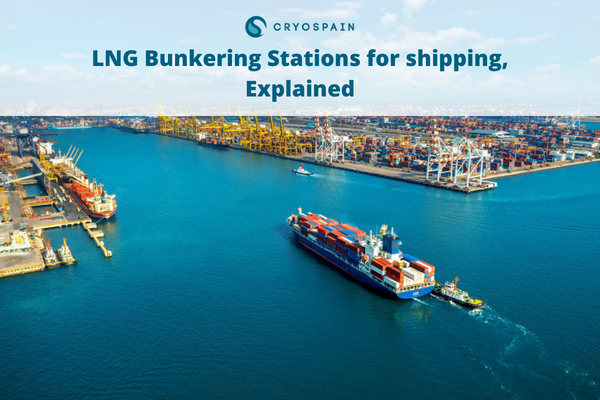The maritime industry is experimenting with the LNG Bunkering station as the solution needed to adapt to these rapidly changing times. In the face of increasingly restrictive regulations regarding ships’ sustainability, the industry is embracing LNG bunkering as a means to reduce this form of transportation’s environmental footprint.
However, while using LNG as fuel means crucial reductions in harmful emissions, it also brings new challenges for the industry, such as a need for specially-designed cryogenic pumps and piping. LNG Bunkering stations and the concept of sea bunkering in general form part of this equation the industry must solve.
What is bunkering at sea and how should it be carried out in order to guarantee maximum security? From our perspective as experts in cryogenic engineering with an extensive catalog of successful bunkering projects, Cryospain brings you the keys to this process.
What is an LNG bunkering station?
A bunkering station is a structure where the transfer of fuel to a vessel can take place. This includes both traditional marine fuels, as well as new, more sustainable alternatives such as LNG.
Bunkering stations have become a key piece in the expansion of maritime transport and crucial to guaranteeing the safety and efficiency of the processes involved.

Short recap: types of bunkering
1 .Truck-to-Ship
Truck-to-Ship (TTS) transfer is the most frequent type of bunkering. Typically, a truck loaded with LNG is connected to the ship via a flexible hose. This is a good option for small-sized vessels looking to minimize their investments.
2. Ship-to-Ship
Ship-to-ship (STS) sea bunkering can take place along the quayside, at anchor or at sea and is the preferred method for bunkering at sea. It may require additional permits, as LNG bunker vessels are considered to be carrying dangerous cargo.
3. Shore to Ship
In this case, LNG is bunkered from an inland tank, station, or terminal that uses pipelines. It involves the use of loading arms that allow for larger hoses and increased efficiency.
Keep reading: Pipe in Pipe: the ideal cryogenic pipes for bunkering plants
Issues and hazards of LNG bunkering operations
LNG bunkering involves the transfer of a cryogenic substance (below – 162 Cº) and, therefore, the following risks have been associated with it:
- Leaks and spills during transferring operations
- Potential cryogenic burns and frostbite to human skin
- Fire and explosions
- Bunker Line Contamination
- Pipe ruptures due to accidentally trapped LNG
- Oxygen depletion that might endanger human crews
Safety aspects to consider when working with LNG Bunkering stations
There are a number of codes and regulations governing LNG bunkering station structures.
Chief among these is the International Code for the Construction and Equipment of Ships Carrying Liquefied Gases in Bulk (IGC Code). This regulation focuses on the bunker vessels carrying the fuel. The IMO IGF Interim guidelines, on the other hand, cover safety aspects for the vessel receiving the LNG bunker fuel.
As a summary, these are some key safety measures that need to be considered for LNG bunkering station operations:
- Weather and tide forecasts need to be checked
- Only specialist personnel are allowed during sea bunkering operations. They must have extensive knowledge of the related hazards and be given detailed instructions both for normal operations and emergency situations.
- Emergency shutdown switches must be available
- Adequate PPE for cryogenic substances and LNG bunkering must be provided
- Pre-bunkering checklists must include transfer procedures such as maximum loading and unloading rates and means of communication, quantity and properties of the supplied LNG, among others.
- Communication between ships must be maintained at all times
- A spill protection plan and containment equipment must be available
- Firefighting equipment must be available
- The temperature and pressure of the tanks needs to be checked before and during operations
- Flow rates must be checked during LNG bunkering, and adjusted if necessary
- Pumping needs to be able to be safely shut off if needed
You may like: Everything about loading arms for transferring liquid or liquefied gas
Cryospain, your LNG bunkering station expert
At Cryospain, our cryogenic engineering expertise has seen us tackle a growing number of successful LNG bunkering projects.
We not only provide engineering consultancy services, we can also handle the design, manufacture and implementation of optimal equipment for bunker station ship projects. These include our pipe-in-pipe systems, vacuum-insulated pipes for LNG, as well tanks and storing facilities and special docks for LNG (including hosepipes, connectors and bunkering-specific loading systems).
As such, we bring a comprehensive end-to-end service to companies looking to implement efficient bunkering equipment, providing both the equipment needed and the know-how to transition seamlessly to sustainable shipping.
Additionally, our services cover all requirements associated with your LNG bunkering station: from the installation of thermal shields to ensure maximum efficiencies, to performing comprehensive maintenance operations, including pipe stress analysis verifications among others. Our experience also means we’re able to undertake tailored projects that cater to each installation’s needs, to find the solution that will guarantee maximum durability and efficiency in the mid and long term.
Want to learn more about LNG Bunkering stations and how to ensure a safe and optimized bunkering project that meets current industry standards and regulations? At Cryospain, we’re ready to help you.
Take a look at our pipe catalog or download our bunkering case study at the port of Rotterdam (The Netherlands) to learn more about how we can help you to make your bunkering operations a reality both safely and efficiently and find out why Cryospain is partnering with the industry’s leaders to facilitate the building of efficient LNG bunkering structures.











 Contacte-nos
Contacte-nos